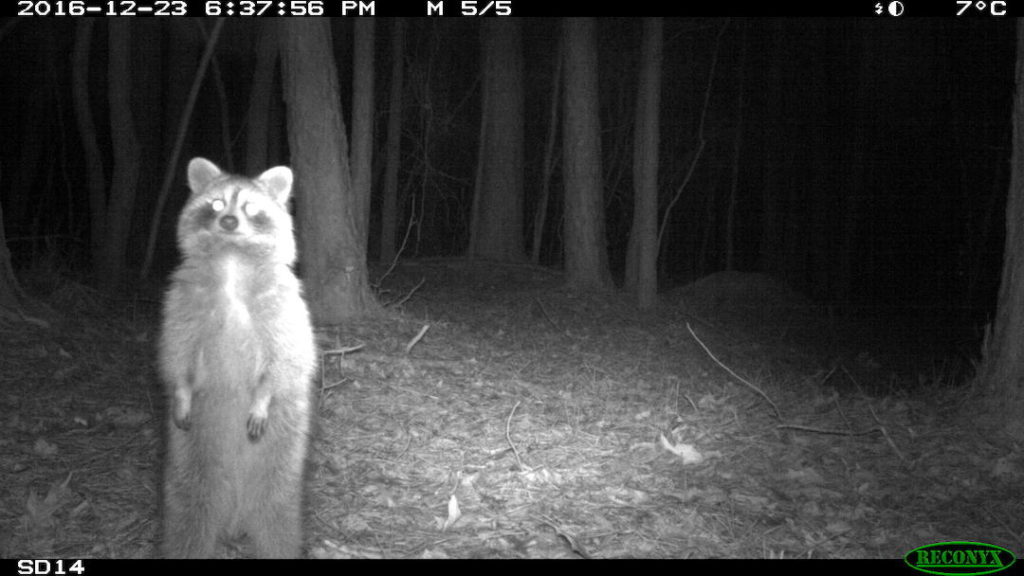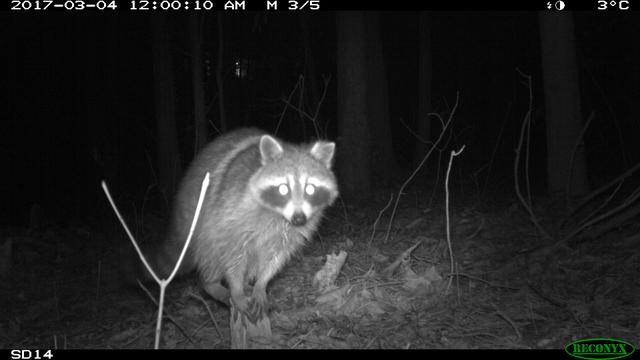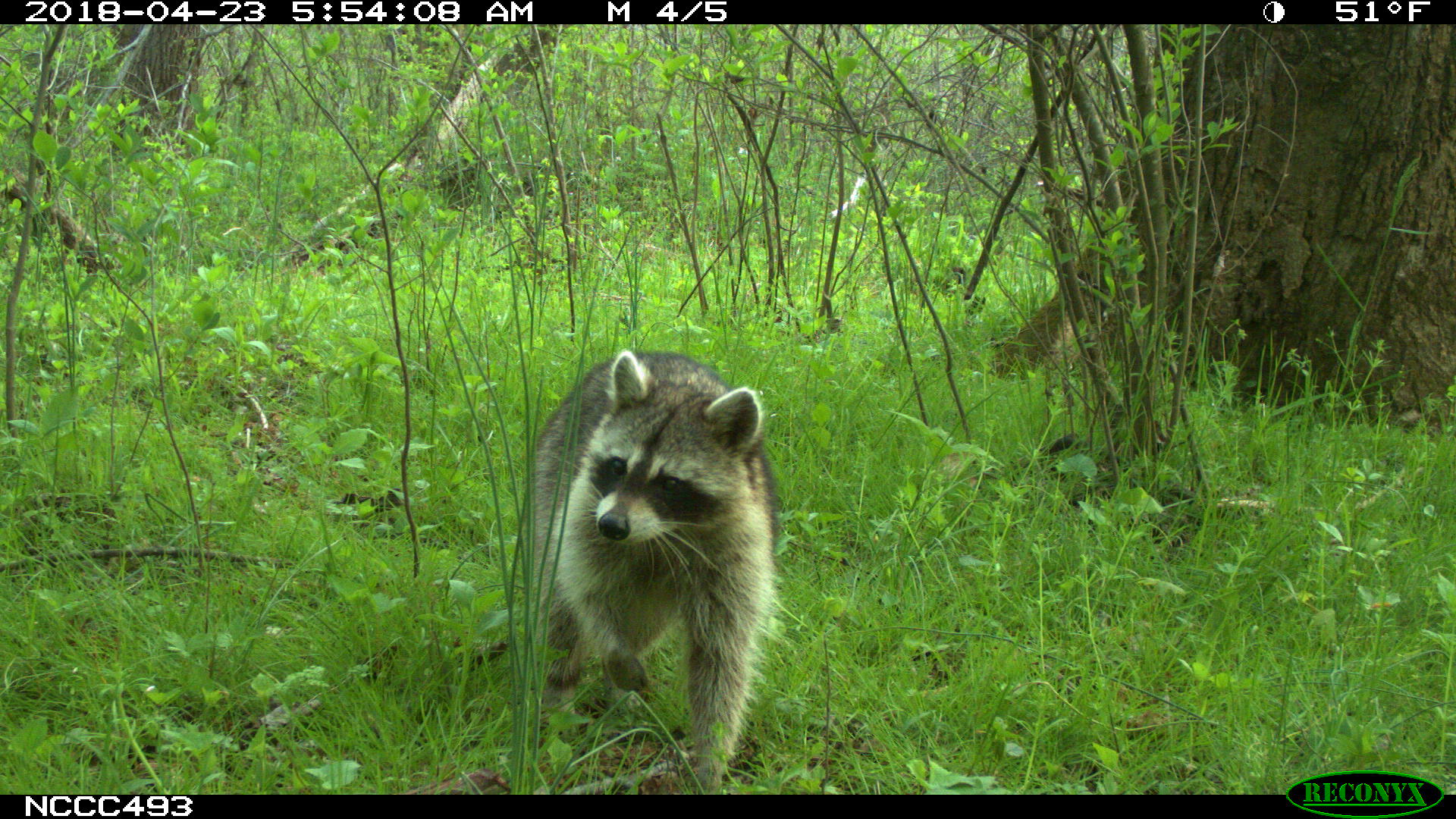*This post contains affiliate links. As an Amazon Associate, I earn from qualifying purchases. Read my Affiliate Links Disclaimer.
I have loved raccoons ever since I was a little girl and even have a gold raccoon necklace. One of my best memories of raccoons is in Allegheny State Park, where we used to visit every year. We were having a picnic near Science Lake and spread out platters of crackers, cheeses, sandwiches, and fruits on a few flat rocks. As dusk turned to darkness, we saw chubby balls of fur crawl down the trees and quite literally surround us. We all ran to the car in fear and left my grandmother trying to fend the raccoons off all by herself!
A few years ago, I was able to participate in research studying how human impacts (like food) may affect Northern raccoons’ (Procyon lotor) social systems. Raccoons thrive in cities and take advantage of the abundance of food cities provide through leftover food and trash (or in the country ignorant tourists). More urbanized raccoons may therefore be different from their rural counterparts in the ways they interact with each other, which may have cascading effects.

Effects of Food on Parasites
Previously, researchers conducted a large-scale experiment where they put dog food out in a series of treatments: clumped in big piles, spread evenly throughout forest, and no food added. The main area of interest for this project was whether food piles affected raccoon social aggregations and space use patterns, thereby having disease implications. These researchers trapped (and released raccoons) to collect blood and parasites as data.
They found that the endoparasite (parasites that live inside the host) species richness of raccoons was high despite the treatment type. Although the food piles increased the group sizes, there were no increases in endoparasite species richness (number of species), and there was actually a decreased richness of indirectly transmitted endoparasites, especially in raccoons of the oldest age classes. The authors hypothesized that this might be because of a decline in the diet diversity which could lead to a decline in the number of parasite species.
For ectoparasites (parasites that live outside the host), they found different reactions in different parasites: the number of ticks was greater in the aggregated raccoons (there are so many ticks in Missouri!), there were no differences in fleas, but louse populations were lower. These results are opposite than what was expected based on previous research at the time, meaning that new research would have to be conducted to figure out the complex interactions between the host and parasites.

Effects of Food on Genetics
I used the above dataset to see if these aggregations affected the spatial and genetic patterns of raccoons. Another researcher on the same project tracked the raccoon movements through radio telemetry collars and I incorporated these raccoon home ranges into my study. We found that raccoons shifted their home ranges in areas where there were piles of food (to include the food clump), but there was no relationship between home range overlap and relatedness. In the other area, where food was spread out, females had more home range overlap with their family members. So the addition of food appeared to attract more “outsider” raccoons, therefore decreasing the overall relatedness. What this means is that the food we leave out for animals, whether it’s on purpose or by accident, might be altering the social systems of animals.

Are Raccoons Disgusted?
I am now analyzing the results of a study on the ability of raccoons to have “disgust.” Using camera traps, I watched raccoons at food piles I set up in the forests of Missouri. Raccoons love this supplemental food and quickly came to eat as in the experiments before. But would they be willing to eat if they thought they could get a disease? We wanted to see this by placing a dead raccoon in the middle of the food pile to see if this deterred raccoons. Because raccoons would see this deceased individual, they might be wary to eat from the food pile, not knowing how this individual died, and afraid to obtain a disease. As controls, we used a stuffed animal and a dead squirrel, which is still a dead animal, but is not related to raccoons and therefore less likely to have the same types of transmissible pathogens.

We did NOT kill any animals for this experiment. I actually had to drive around looking for road-killed raccoons and squirrels (in case you are wondering, squirrels are easy, raccoons are much harder to find and are usually in areas of high traffic like highways). Stay tuned for the results.
Crazy Raccoons
Through my camera trap work on the eMammal project, I’ve seen raccoons do some crazy things. The first is eat a squirrel on camera trap and the second is chase a deer through the forest. I’ve actually seen this twice on my camera traps now. Why would a raccoon do this? Roland Kays interviewed me on this very subject, so check out the video below to find out why:
Do you have a funny raccoon story? Share below!
To help you identify all of the mammals you see in North America, I highly recommend the Mammals of North America field guide, written by my boss, Roland Kays!

SaveSave
SaveSave
SaveSave
SaveSave
SaveSave
SaveSave
Love this post? Share it with friends!



